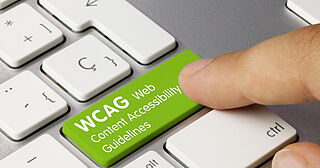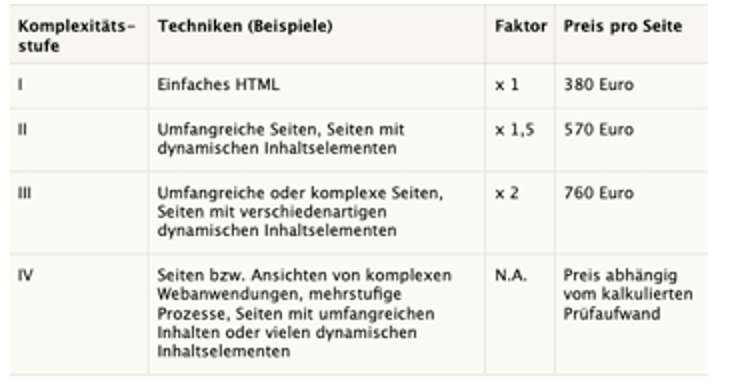An online presence is barrier-free if existing limitations in hearing, seeing, moving or processing information do not adversely affect how the web can be used. The aim is to enable all people, including those with disabilities, to take advantage of digital offerings. This includes not only the actual website, but also all media and documents such as videos and PDFs that are embedded on the site. In recent years, the topic of digital accessibility has received more and more attention. At the latest since public institutions have been legally obligated to ensure digital accessibility since September 2020, many website operators have become aware of the relevance and scope.
In the past, people with disabilities often needed help to manage their daily lives. For example, they had to have website content read out to them and applications filled out. By removing digital barriers, it is now possible for deaf and visually impaired people, as well as older people, to understand and use Internet services.
Digital barriers include:
- People with visual impairments have difficulty recognizing text and form fields that stand out only slightly against the background.
- Without subtitles, the deaf or hard of hearing cannot use videos.
- Without textual descriptions for images, buttons and forms, blind people cannot use websites.
What options do I have to check a website for accessibility?
There are various ways to check a website for accessibility according to the requirements of the Barrier-Free Information Technology Ordinance (BITV 2.0). If you want to check your online offering, you can choose between two variants: With the help of automatic checks or a test procedure that is carried out manually by people either by experts from the testing association or in a self-assessment. Both procedures can also be combined. Depending on the type of test, it is more or less time-consuming and cost-intensive.
With the BITV Self-Assessment (Barrier-free Information Technology Ordinance Self-Assessment), you can use a free web-based tool to check the accessibility of your website and mobile applications yourself. It is based on the requirements of the Barrier-free Information Technology Ordinance (BITV) in Germany, which regulates the accessibility of websites and mobile applications for people with disabilities. The self-assessment contains a series of questions that website operators must answer to evaluate the accessibility of the website or application. Using a checklist of 98 testing steps, you can assess the barrier status of your website and identify potential barriers.
After you have created a BITV self-assessment, you can save it and continue working on it later. Results can be displayed in a clear format (results per test step or results per page). However, the reliability of your results depends on how familiar you are with the BITV test procedures.
These simple tests give you a first impression of the accessibility of your website. The Easy Checks were deliberately developed in a reduced form and cover only a small part of the accessibility requirements. Included in the test are checkpoints that are easy to test such as document titles, alternative texts, contrasts, magnification and some more.
Due to the simplicity of the test, barriers to access may still exist for people with disabilities despite a successful evaluation. Conversely, you may find barriers that don't exist.
If you want to test your website comprehensively, you should use the self-assessment or commission the BIK BITV test.
There are some free online tools such as AChecker, Google Lighthouse or Wave to automatically test websites for their accessibility.
While they can detect a large number of formal deficiencies, they can by no means check compliance with the standard, since automated testing only maps a fraction of the accessibility requirements according to BITV. For example, an automated tool can check whether an image has an alternative text description, but it cannot assess whether the description is correct. This can quickly lead to misinterpretations about the current state of digital accessibility. Furthermore, some of the feedback provided by these tools can only be understood by experienced web developers.
Nevertheless, using an automated tool can be helpful in some cases. E.g. if you want to get a quick first impression of your reachability situation. Furthermore, automated tools are a useful addition to personal testing.
The BITV test by an official testing body is a comprehensive and reliable test procedure for checking the accessibility of web offerings. It compares the compliance of the web presence with the requirements of the BITV. In addition, it provides comments to support the optimal implementation of accessible online offerings and identifies optimization needs. It should be noted, however, that this feedback is often only understandable for experienced developers with sufficient background knowledge on the subject of accessibility.
The BITV test was developed by the BIK project (Barrier-free Information and Communication) in close cooperation with disability organizations, web service providers and experts and has been an established test procedure in Germany for more than 15 years. It is based on the requirements of the Barrier-Free Information Technology Ordinance (BITV) in Germany, which regulates the accessibility of websites and mobile applications for people with impairments. To order such a BIK BITV test, a request form can be filled out on the BIK website.
The BITV test checks the website or applications in 98 test steps, which are divided into different categories such as text, images, navigation and interaction, and ends with a detailed test report.
If all applicable test steps are fulfilled and the tested pages of your offer are rated "compliant", you can include the "BIK BITV compliant" test mark on the website and document the good test result externally via a link.
The requirements to achieve the test mark "conformity according to BITV 2.0 / EN 301 549" are very demanding and require thorough preparation. Therefore, two official tests are often necessary.
- In the first test, the current state of accessibility is determined and optimization possibilities are identified with the help of a detailed test report.
- The second test verifies the improved offer. Ideally, this test confirms conformity and then leads to the BIK test mark.
What are the costs for a BITV test?
As mentioned above, a BITV test self-assessment is free of charge, but this test is very complex and time-consuming.
There is no flat price for a BITV test by experts from the testing association, as the costs can vary depending on the provider and the scope of the test. Some providers offer free consultations, while others charge for their preliminary or final consultations.
The cost is also related to the level of complexity and the number of pages that need to be tested, so it's a good idea to check with different providers about costs and services to find the most appropriate provider for your situation.
On the website www.bitvtest.de you can find out about test centers for the BITV test in accordance with the BIK test procedure and get an overview of pricing online in advance.
Example:
- An imprint or simple text image page has complexity level 1 and thus a factor of 1. The basic price per page is 380 euros. Thus, the page to be tested costs 380 euros.
- Extensive or complex pages have complexity level 3 and thus a factor of 2. This is multiplied by the basic price per page of 760 euros. Thus, the page to be tested costs 1,520 Euro.
The total price is the sum of the individual page prices.
Conclusion: Does an official BITV certification make sense for my website?
The question cannot be answered with a clear yes here. The fact is: The BITV (Barrier-free Information Technology Ordinance) obliges web offers of the federal government and other public bodies to be barrier-free.
An official BIK BITV test helps you reliably check the accessibility status quo of your existing website. In addition, you can identify and correct existing deficiencies to prevent potential sanctions for non-compliance. Besides the mandated BIK BITV test by official testing bodies, the BITV self-assessment can be a good alternative if you want to avoid costly testing. This option is aimed at people who have the necessary time resources and know-how, as the reliability of the results depends on how well you familiarize yourself with the individual testing steps. However, you should note that the final test report cannot be used as proof of accessibility and cannot serve as a positive advertisement for you.
In addition, it should be mentioned that digital accessibility offers further advantages besides the legal necessity for public bodies. The usability of a website is optimized for all users, offers are easier and more intuitive to use. Texts are written in a simpler way, well structured and thus easier to understand. In this way, accessibility not only helps people with disabilities, but also all other users.
How we can support your company around the topic BITV and accessible websites:
- We offer comprehensive advice on the requirements and guidelines of the BITV and perform an accessibility analysis of your existing website to identify potential weaknesses.
- We are happy to support you in redesigning or adapting your website to meet the requirements of BITV. This includes the design of a user-friendly and accessible user interface as well as the implementation of accessible techniques and functions. In addition, we can support you in creating accessible content.
- In training courses and workshops, we can raise awareness of accessibility and impart knowledge about the implementation of accessible websites according to BITV. This can help ensure that your organization complies with accessible standards in the long term.
- If desired, we can also help you obtain an official accessibility certificate for your website. This can officially validate your efforts to create an accessible online presence.
Oliver Parrizas will be happy to answer any questions you may have on the subject. +49-800-911-91-91





